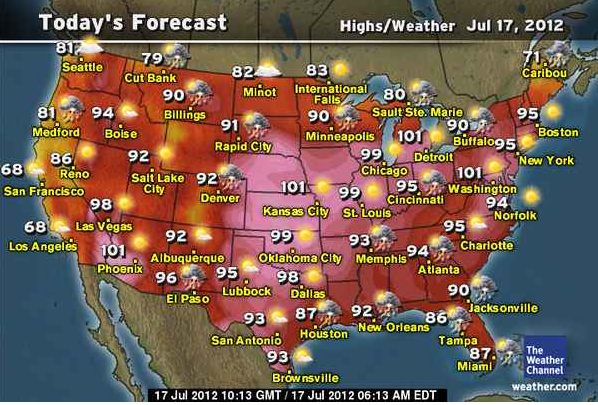Here’s what America looks like today, via The New York Times’ Jim Roberts:

Yeah, it’s July, but this is ridiculous. Ri. Dic. U. Lous. The coolest places east of the Rockies are Tampa and Houston? Madness. Yesterday, we only broke eight all-time record highs. Today we’re likely to do a little better.
Which is appropriate! Today, we celebrate an important anniversary: the 110th birthday of the air conditioner.
A junior engineer from a furnace company figured out a solution so simple that it had eluded everyone from Leonardo da Vinci to the naval engineers ordered to cool the White House when President James A. Garfield was dying: controlling humidity. “If you could keep humidity at a balanced rate,” said Marsha E. Ackermann, the author of “Cool Comfort: America’s Romance With Air-Conditioning” (Smithsonian Books, 2002), “it would not seem so sweltering and things would not be dripping all over.”
It was a world-changing innovation. “Air-conditioning, in the broad sense, had a profound effect on the way people lived and worked,” said Bernard A. Nagengast, an engineering consultant who specializes in the history of air-conditioning and heating. “It allowed industry to operate in ways it couldn’t operate before, in places it couldn’t operate before.”
See The Atlantic Cities’ article, “Cities That Wouldn’t Exist Without Air Conditioning.” And while you’re at it, compare it to the map at the top of this page.
We’ve been covering air conditioners a lot, because it’s always a billion degrees outside. Given the heat and the ongoing drought, some members of Congress have called for hearings into the role of climate change. Of course, Republicans blocked the idea, realizing that the final hurdle to broad acceptance of the concept and the entire dismantling of the fossil fuel industry is testimony from expert witnesses on Capitol Hill.
Incidentally, here’s the first air conditioner installed in the Capitol in June 1938. It cost $3.5 million in 1938 dollars — some $57 million today.

Photo from the Library of Congress.
If you’re looking for a less expensive and more thorough break from the heat, there’s one surefire location we can recommend:
Current Conditions : -90F, Clear – 6:00 PM VOST Jul. 17 goo.gl/fb/OeUL4
— Antarctic News (@AntarcticaNews) July 17, 2012
Every day, the United States Antarctic Program shares its weather conditions. On most days, it’s not appealing. On some days, like today, it kind of is. But it’s not a great way to beat the heat: The carbon footprint of travel to Antarctica is pretty hefty. (Also, it takes a long time and is dangerous.)
Our recommendation: Stay home and turn on a fan. If you must use your air conditioner, know that it’s probably expecting a cake.
Update: Without consulting us, Google Street View just added images from Antarctica. So now you can tour Antarctica and run your air conditioner! Win-win.



